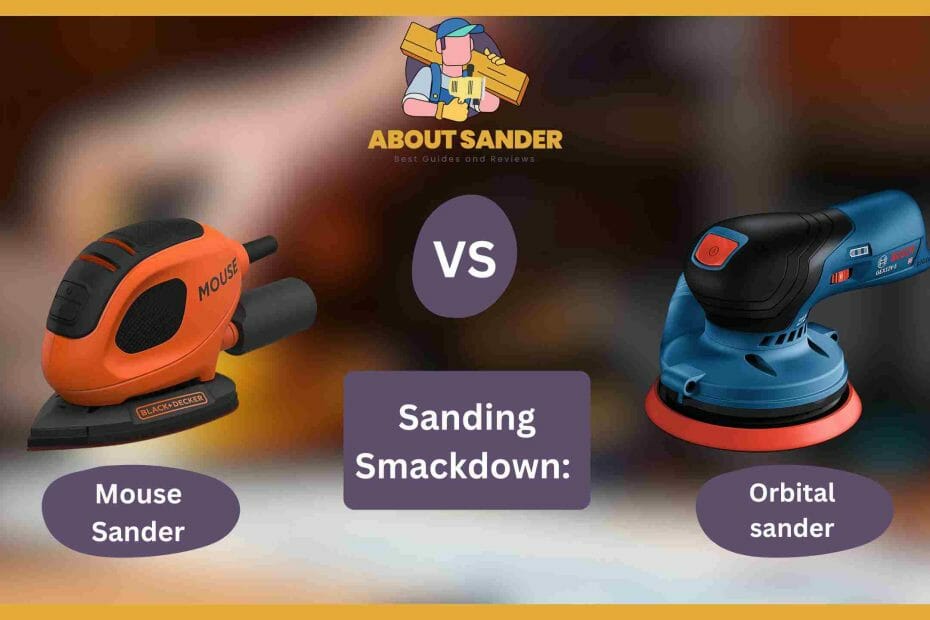When sanding, having the right tool can make all the difference. In this article, we’ll take a closer look at the mouse sander vs orbital sander debate, comparing each tool’s features, benefits, and drawbacks to help you determine which is the best fit for your next DIY project.
Key Takeaways
Choosing the right sander is crucial for a successful sanding project.
Mouse sanders are best for intricate and detailed work, while orbital sanders are perfect for larger, flat surfaces.
The type of sandpaper used can greatly impact the performance of both sanders.
While both sanders have advantages and disadvantages, understanding their differences is essential to making an informed decision.
Always prioritize safety measures, such as wearing protective gear, when using power tools like sanders.
Here is all about Mouse Sander
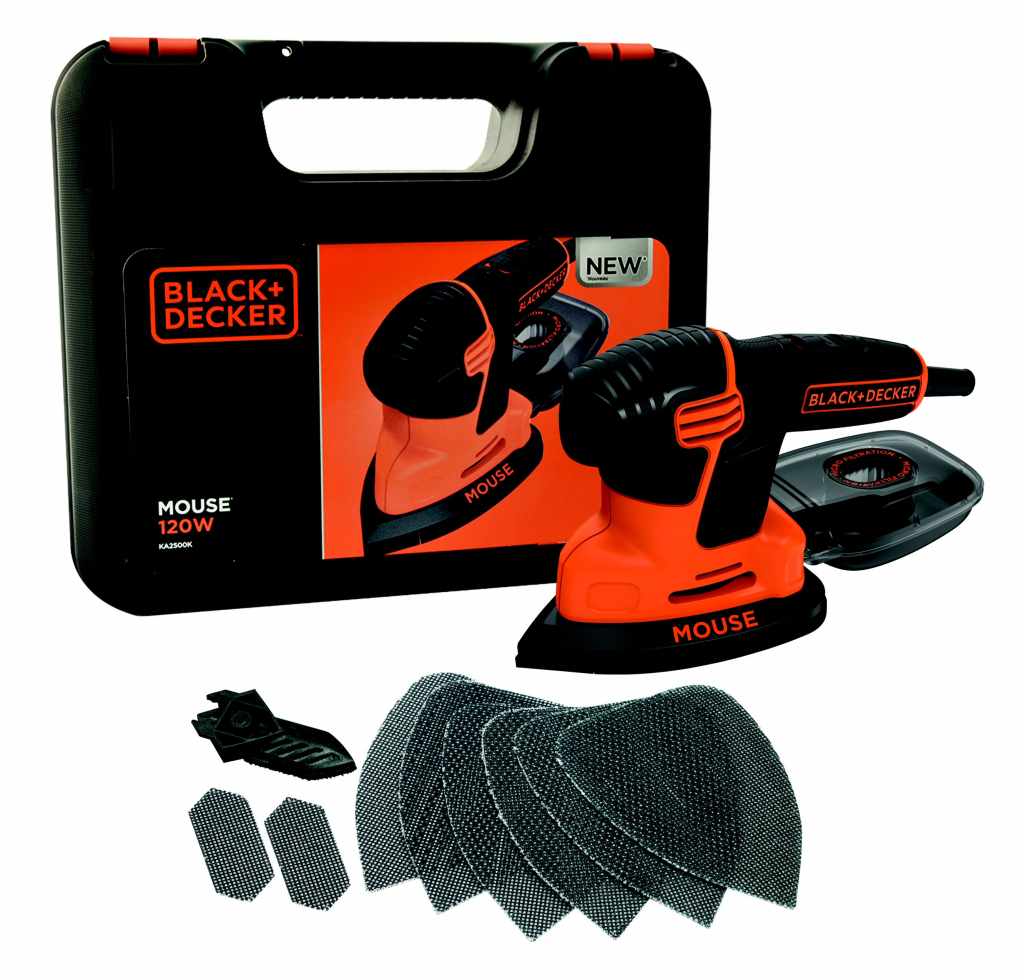
| Mouse Sander | Type | Specifications | Pros | Cons | Features |
| Black+Decker Mouse Sander | Corded | 120V, 1.2A, 14,000 OPM | Lightweight, compact, ergonomic design | Short cord length, not suitable for heavy-duty sanding | Finger attachment for hard-to-reach areas, dust collection canister |
| Bosch GMS Mouse Detail Sander | Corded | 120V, 1.0A, 12,000 OPM | Versatile, precision sanding, comfortable grip | Dust collection could be better, may not be as durable as other models | Multiple sanding attachments, finger attachment for tight spaces, variable speed control |
| Tacklife PMS01A Mouse Detail Sander | Corded | 120V, 1.1A, 12,000 OPM | Lightweight, compact, low vibration | Dust collection could be better, some reports of sandpaper slipping | Multiple sanding attachments, finger attachment for tight spaces, dust collection canister |
| Ryobi CFS1503GK Mouse Sander | Cordless | 18V, 11,000 OPM | Cordless convenience, comfortable grip | Battery life may be short, not suitable for heavy-duty sanding | Dust collection bag, multiple sanding attachments, LED work light |
| Genesis GMT15A Mouse Detail Sander | Corded | 120V, 1.5A, 21,000 OPM | High power output, precision sanding, comfortable grip | May be too powerful for delicate surfaces, dust collection could be better | Multiple sanding attachments, finger attachment for tight spaces, dust collection canister |
A mouse sander, also known as a detail sander, is a small handheld power tool used for sanding and smoothing small, tight spaces that are difficult to reach with larger sanders. These sanders are often used to finish furniture, cabinets, and other woodworking projects where precision and control are essential.
These are best 5 features of Mouse Sander
If you’re in the market for a sander, you’ve probably encountered the mouse and orbital sander. Both handheld power tools used for sanding and smoothing surfaces have key differences in features and capabilities. In this article, we’ll focus on the mouse sander and its features compared to the orbital sander.
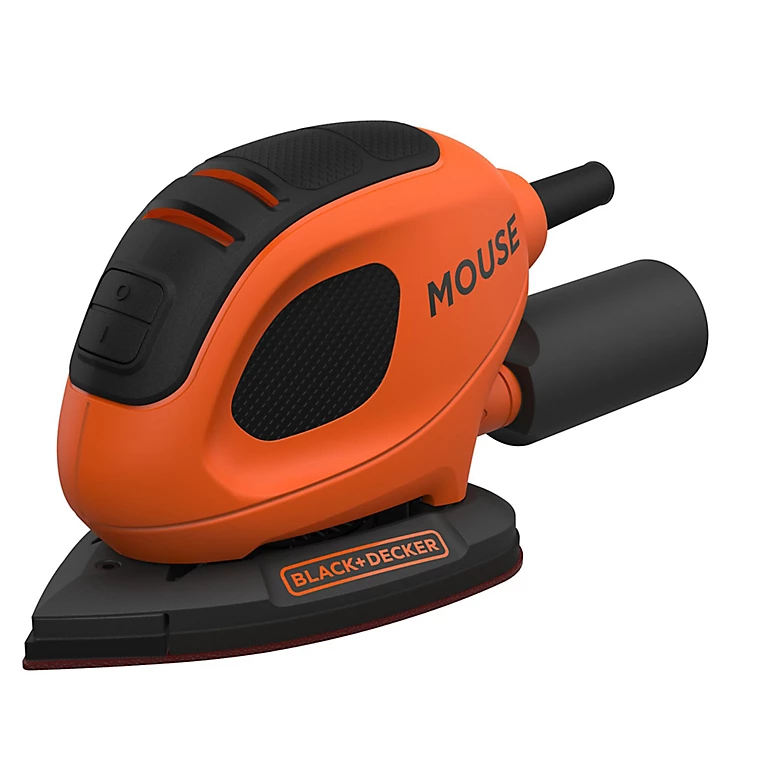
1: Triangular Sanding Pad for Precise Sanding
One of the standout features of the mouse sander is its triangular sanding pad. This design allows for precise sanding in tight spaces and corners that are difficult to reach with larger sanders. The pointed tip of the pad also makes it easier to get into small crevices and corners, giving you more control over your sanding.
2: Lightweight and Compact Design for Easy Handling
Another feature of the mouse sander that makes it popular among DIY enthusiasts and professionals is its lightweight and compact design. The smaller size and lighter weight make it easier to handle and maneuver, even for extended periods.
This can be especially beneficial when working on intricate or detailed projects that require more precision and control.
3: Vibration Control for Reduced Fatigue
Some mouse sanders have vibration control features that help reduce hand fatigue and discomfort during use. This is especially important for larger sanding projects that can take a toll on your hands and wrists over time.
By minimizing the amount of vibration felt during use, these features make it easier to sand for longer periods without experiencing discomfort.
4: Variable Speed Settings for Increased Control
Many mouse sanders also come with variable speed settings that allow you to adjust the speed of the sander to suit different materials and applications. This gives you greater control over your sanding and allows you to achieve the best results possible on various surfaces.
5: Compatible with a Range of Sandpaper Grits
Finally, the mouse sander is compatible with a wide range of sandpaper grits, allowing you to choose the right abrasive material for your project. Whether you need a fine grit for finishing work or a coarser grit for removing paint or other stubborn materials, a sandpaper option will work with your mouse sander.
Here are a few things we like about Mouse Sander.
When sanding, having the right tool can make all the difference. While the mouse sander and orbital sander are handheld power tools used for sanding and smoothing surfaces, the mouse sander has some unique advantages that set it apart from its larger counterpart.
1: Precision Sanding in Tight Spaces
The triangular sanding pad of the mouse sander makes it the perfect tool for sanding in tight spaces and corners. The pointed tip of the pad allows for precise sanding and the ability to get into small crevices and corners that an orbital sander cannot.
2: Lightweight and Easy to Maneuver
Another advantage of the mouse sander is its lightweight and compact design, making it easy to maneuver and handle during extended periods of standing. The smaller size and lighter weight make it a popular choice among DIY enthusiasts and professionals who require more control and precision over their sanding projects.
3: Reduced Vibration for Increased Comfort
Many mouse sanders have vibration control features that minimize the vibration felt during use. This is especially important for larger sanding projects that can cause discomfort and fatigue in the hands and wrists. By reducing the vibration, the mouse sander is a more comfortable tool to use for longer periods.
4: Versatile and Compatible with a Range of Sandpaper Grits
The mouse sander is compatible with a wide range of sandpaper grits, allowing it to be used for various sanding tasks. The mouse sander can handle everything from fine grits for finishing work to coarser grits for removing paint or other stubborn materials. This versatility makes it a popular choice for DIY enthusiasts and professionals alike.
5: Affordable and Accessible
Finally, the mouse sander is more affordable and accessible than the orbital sander. With a lower price point, it is a great option for those on a budget or beginners just starting to build their tool collection. Additionally, the mouse sander can be found in most hardware stores and online retailers, making it easy to purchase and obtain.
Here are a few things we don’t like about Mouse Sander.
While the mouse sander has several advantages over its larger counterpart, the orbital sander, it also has a few drawbacks to consider when deciding which tool is right for your sanding project. This article will discuss the top five cons of using a mouse sander compared to an orbital sander.

1: Limited Sanding Surface Area
The mouse sander’s small size means it has a limited sanding surface area compared to the orbital sander. While the mouse sander is ideal for sanding in tight spaces and corners, there may be better choices for larger projects requiring more surface area. This can lead to longer sanding times and a less efficient sanding process.
2: Less Power and Sanding Speed
Due to its smaller size, the mouse sander has less power and sanding speed than the orbital sander. While this may be a minor issue for smaller projects, it can be a drawback when sanding larger surfaces. The reduced power and speed may result in longer sanding times and a less effective sanding process.
3: Limited Dust Collection Capacity
Another disadvantage of the mouse sander is its limited dust collection capacity. The smaller size of the tool means that it may need to be able to collect more dust than an orbital sander, leading to more frequent dust disposal or clean-up. This can be time-consuming and messy, especially when working on larger projects.
4: Limited Durability
Due to its lightweight and compact design, the mouse sander may not be as durable as the orbital sander. The smaller size and less powerful motor may prevent the tool from wearing out faster, leading to the need for more frequent replacements. This can be a cost consideration for those who plan to use the tool frequently or for larger projects.
5: Limited Range of Sanding Motion
Finally, the mouse sander has a limited range of sanding motion compared to the orbital sander. While the orbital sander moves in a circular motion, the mouse sander’s triangular pad moves back and forth.
What you need to know about orbital sander?
| Orbital Sander | Type | Specifications | Pros | Cons | Features |
| Makita BO5041K Random Orbit Sander | Corded | 120V, 3.0A, 4,000-12,000 OPM | Variable speed control, low vibration, efficient dust collection | May be heavy for some users, cord length could be longer | Large sanding pad, adjustable front handle, hook-and-loop abrasive disc system |
| DEWALT DWE6423K Random Orbit Sander | Corded | 120V, 3.0A, 8,000-12,000 OPM | Low vibration, efficient dust collection, ergonomic design | May be too powerful for delicate surfaces, some reports of durability issues | Dust-sealed switch, rubber over-molded grip, easy-to-replace hook-and-loop abrasive discs |
| Bosch ROS20VSC Random Orbit Sander | Corded | 120V, 2.5A, 7,500-12,000 OPM | Low vibration, efficient dust collection, variable speed control | May be too powerful for delicate surfaces, dust collection could be better | Hook-and-loop disc attachment, microfilter dust canister, ergonomic design |
| BLACK+DECKER BDERO100 Random Orbit Sander | Corded | 120V, 2.0A, 12,000 OPM | Lightweight, compact, low vibration | May not be as durable as other models, dust collection could be better | Hook-and-loop sanding disc attachment, dust-sealed power switch, rubber over-molded grip |
| DEWALT DCW210B Random Orbit Sander | Cordless | 20V, 8,000-12,000 OPM | Cordless convenience, efficient dust collection, low vibration | Battery life may be short, may be heavier than corded models | Brushless motor for longer runtime, variable speed control, dust-sealed switch |
An orbital sander is a handheld power tool used to smooth and polish various surfaces, such as wood, metal, and plastic. Unlike other types of sanders that move in a circular motion, an orbital sander has a square or rectangular pad that vibrates in tiny circles, allowing for a random orbit pattern.
Here are top 5 features of orbital Sander?
An orbital sander can be a highly effective tool when sanding large surfaces. Unlike a mouse sander, an orbital sander has a larger sanding surface area and more power, making it ideal for sanding larger projects. In this article, we’ll discuss the top five features of an orbital sander.
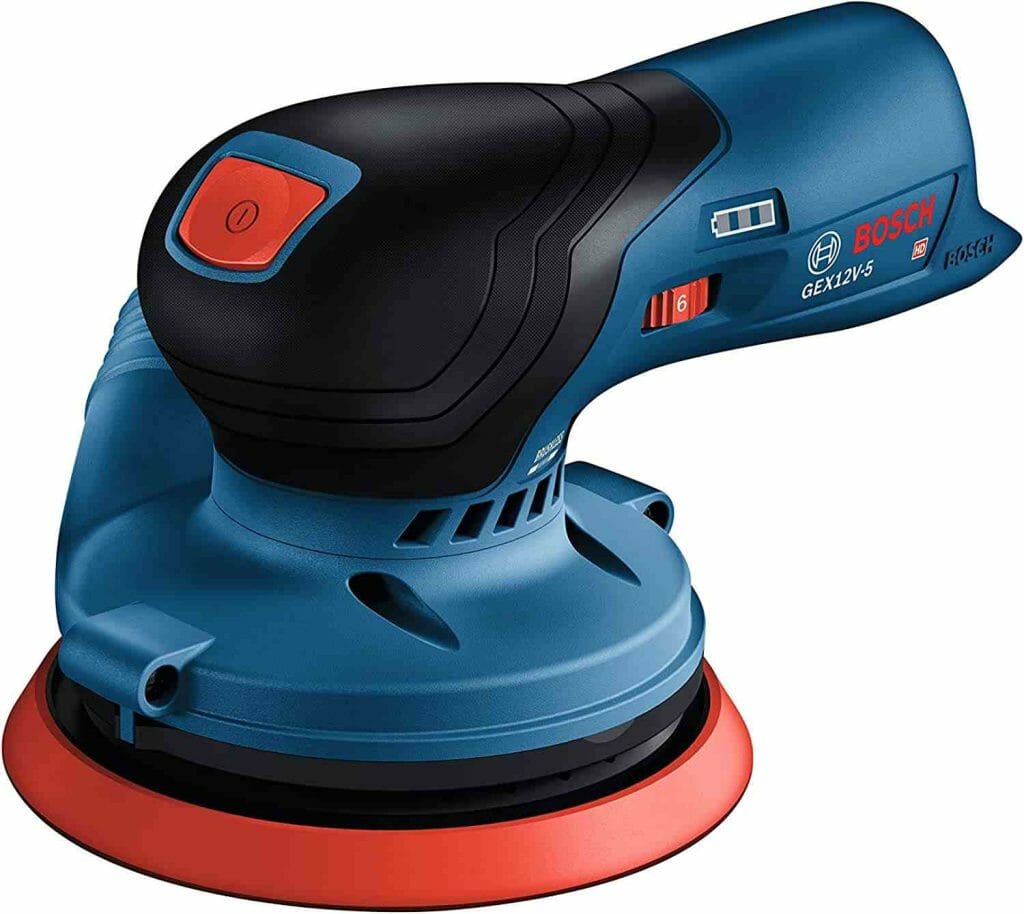
1: Large Sanding Surface Area
One of the main advantages of an orbital sander is its larger sanding surface area. This allows quicker and more efficient sanding of larger projects, such as tables, floors, and walls. With a larger sanding surface area, the orbital sander can cover more ground quickly, making it a more efficient tool for larger sanding projects.
2: High-Powered Motor
An orbital sander typically has a more powerful motor than a mouse sander, which enables it to sand more effectively and quickly. With a more powerful motor, an orbital sander can easily tackle tough sanding tasks and remove stubborn paint or finishes from surfaces.
3: Variable Speed Control
Many orbital sanders come equipped with variable speed control, allowing the user to adjust the sander’s speed according to the project’s needs. This feature can be particularly useful when working with delicate materials, as a slower speed can help prevent damage to the surface being sanded.
4: Effective Dust Collection
An orbital sander typically has a more effective dust collection system than a mouse sander, which is important for keeping the work area clean and reducing the risk of health problems associated with dust inhalation.
Most orbital sanders come with a dust bag or can be connected to a vacuum system, which collects dust and debris as the user sands.
5: Versatility
Orbital sanders are highly versatile tools that can be used for various sanding tasks, including sanding, smoothing, and polishing surfaces. They can be used on various materials, including wood, metal, and plastic.
Here are a few things we like about Orbital Sanders
If you’re looking for a powerful and efficient tool for sanding larger surfaces, an orbital sander may be just what you need. An orbital sander has a larger sanding surface area and more power than a mouse sander, making it more effective for sanding larger projects. In this article, we’ll be discussing the top five pros of an orbital sander.
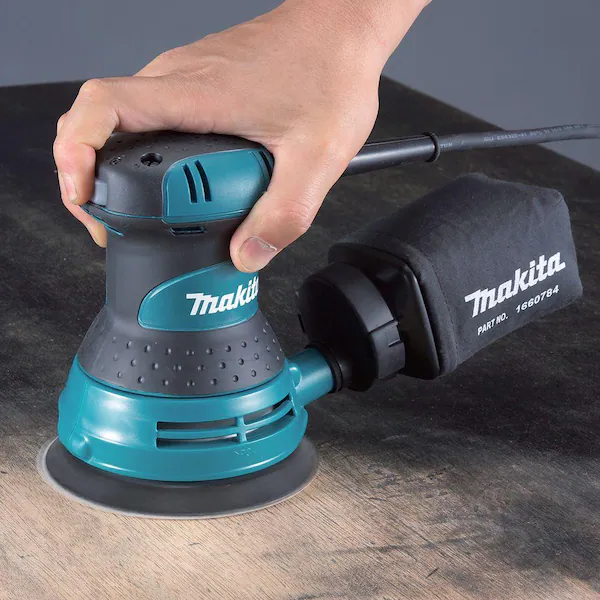
1: Efficient Sanding of Large Surfaces
One of the main advantages of an orbital sander is its ability to quickly and efficiently sand large surfaces. An orbital sander can cover more ground in less time with a larger sanding surface area and more power than a mouse sander.
2: Versatility
Orbital sanders are highly versatile tools that can be used for a wide range of sanding tasks. They can be used on various materials, including wood, metal, and plastic, and can be used for sanding, smoothing, and polishing surfaces.
This versatility makes them a great choice for professionals and DIYers needing a reliable tool to handle various sanding tasks.
3: Smooth Finish
One of the main benefits of using an orbital sander is the smooth finish it can produce. With its random orbit pattern, an orbital sander is less likely to leave swirl marks or scratches on the sanded surface. This results in a smooth, polished finish that can make your project look more professional and well done.
Here are a few things we don’t like about Orbital Sanders
While an orbital sander has several advantages over a mouse sander, there are also some downsides to consider before purchasing. This article will discuss the top five cons of an orbital sander.
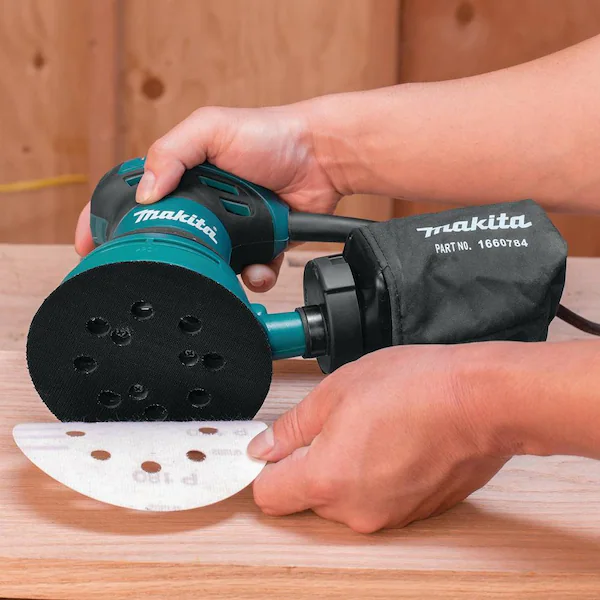
1: Higher Cost
One of the main disadvantages of an orbital sander is its higher cost than a mouse sander. Due to its larger size and more powerful motor, an orbital sander can be significantly more expensive than a mouse sander. This can make it a less appealing option for DIYers or those on a tight budget.
2: Larger Size and Weight
An orbital sander’s larger size and weight can make it more difficult to maneuver in tight spaces or overhead positions. This can make it less ideal for smaller projects or those needing sand in hard-to-reach areas. In addition, the weight of the sander can cause fatigue during extended sanding sessions.
3: Potential for More Damage
While an orbital sander can produce a smooth finish on larger surfaces, it can also be more prone to causing damage if not used correctly. The larger sanding surface area and more powerful motor can make it easier to accidentally sand too deeply or unevenly, resulting in visible damage to the sanded surface.
4: Limited Sanding Speed Options
Most orbital sanders have limited sanding speed options, making it difficult to achieve the desired finish on certain materials or situations. While a mouse sander may have more speed options, an orbital sander typically has a single-speed setting, which may only be ideal for some sanding tasks.
5: Noise and Vibration
The more powerful motor of an orbital sander can result in more noise and vibration than a mouse sander. This can make it a less desirable option for those who need to sand in a quiet environment or are sensitive to vibrations. In addition, the noise and vibration can cause fatigue and discomfort during extended sanding sessions.
Let’s do comparison of both sanders
| Mouse Sander vs Orbital Sander | Mouse Sander | Orbital Sander |
| Type | Handheld | Handheld/Corded/Cordless |
| Sanding Motion | Back-and-forth, Vibrating | Random Orbiting |
| Speed Control | Limited | Variable Speed Control |
| Motor Power | Low | High |
| Sanding Pad Size | Small | Large |
| Ideal for | Small, tight spaces, detail work | Large, flat surfaces |
| Vibration | Moderate-High | Low |
| Dust Collection | Limited | Efficient |
| Pros | Lightweight, easy to maneuver, precise sanding | Efficient sanding, low vibration, better dust collection |
| Cons | Limited power, small sanding pad, limited dust collection | Heavier, bulkier, may be too powerful for delicate surfaces |
| Key Differences | Sanding motion, ideal usage, sanding pad size | Speed control, motor power, vibration |
| Similarities | Handheld operation, electric power, sanding discs with hook-and-loop attachment | Efficient dust collection, ergonomic design |
| Mouse Sander vs Orbital Sander | Mouse Sander | Orbital Sander |
When to use a Mouse Sander?
A mouse sander, also known as a detail sander, is a compact and maneuverable tool designed for precision work. Its triangular shape and small sanding pad make it an excellent choice for sanding intricate and hard-to-reach areas. When should you consider using a mouse sander?
1. Detailed Sanding: When you need to work on detailed surfaces, such as corners, edges, and curves, a mouse sander shines. Its compact size allows you to sand with accuracy and control.
2. Fine Finishes: If you’re striving for a refined finish, especially on smaller projects or delicate materials, a mouse sander can provide the meticulous sanding required.
3. Tight Spaces: In confined or tight spaces where larger sanders struggle to access, a mouse sander’s compact design proves invaluable.
4. Surface Preparation: When preparing surfaces for painting, staining, or varnishing, a mouse sander ensures thorough and uniform sanding.
When to use an Orbital Sander?
An orbital sander, also known as a random orbital sander, is a versatile tool that combines efficiency with versatility. It features a circular sanding pad that moves in both a rotating and an oscillating motion. So, when does an orbital sander make the most sense?
1. Sanding Large Areas: When dealing with large flat surfaces, an orbital sander covers more ground quickly. It’s perfect for tabletops, doors, and wide panels.
2. Smooth Material Removal: For efficient material removal without leaving visible swirl marks, an orbital sander’s dual motion delivers consistent results.
3. Intermediary Grits: When transitioning between grits during a sanding process, an orbital sander can help blend different levels of sanding seamlessly.
4. Flat Sanding: When you require flat and even surfaces, such as smoothing out uneven boards or leveling wood joints, an orbital sander excels.
Ultimately, your choice between a mouse sander and an orbital sander depends on the specifics of your project. If precision, intricate details, and hard-to-reach areas are a priority, the mouse sander is your go-to. On the other hand, for larger surfaces, efficient material removal, and versatile sanding, the orbital sander is the tool of choice.
In conclusion, understanding the strengths of each sander type will empower you to make an informed decision, ensuring that your sanding tasks are not only effective but also tailored to your project’s unique requirements.
FAQs
Here are 5 FAQs about Mouse Sander vs Orbital Sander:
What is the difference between a mouse sander and an orbital sander?
Mouse sanders and orbital sanders differ in their sanding motion and ideal usage. Mouse sanders have a back-and-forth, vibrating motion and are ideal for small, tight spaces and detail work. On the other hand, orbital sanders have a random orbiting motion and are best for large, flat surfaces.
Are mouse sanders less powerful than orbital sanders?
Yes, mouse sanders generally have lower motor power compared to orbital sanders. This is because they are designed for lighter sanding tasks and are ideal for delicate surfaces. However, they are still efficient and precise for their intended usage.
Do orbital sanders have better dust collection than mouse sanders?
Yes, orbital sanders typically have better dust collection systems than mouse sanders. They have efficient dust collection ports and filters that capture most dust generated during sanding. This results in a cleaner workspace and less respiratory irritation for the user.
Conclusion – Making the Right Choice
Ultimately, your choice between a mouse sander and an orbital sander depends on the specifics of your project. If precision, intricate details, and hard-to-reach areas are a priority, the mouse sander is your go-to. On the other hand, for larger surfaces, efficient material removal, and versatile sanding, the orbital sander is the tool of choice.
In conclusion, understanding the strengths of each sander type will empower you to make an informed decision, ensuring that your sanding tasks are not only effective but also tailored to your project’s unique requirements.

Why Trust About Sanders?
When it comes to the world of sanding and sanders, you need a trusted source of information and guidance to ensure you achieve those perfect finishes. That's where I come in – I'm Martin, a dedicated sanding enthusiast with a relentless passion for attaining flawless surfaces. With years of hands-on experience in the sanding industry, I've honed my skills and expertise to provide you with the most reliable and accurate insights. What sets me apart is my commitment to excellence. I meticulously handpick each sander after rigorous testing, ensuring that only the best tools make it to your hands. My goal is to empower you with the knowledge and recommendations you need to tackle any sanding task confidently. When you trust About Sanders, you're putting your faith in a seasoned expert who shares your passion for perfection and strives to deliver top-notch information and reviews for every sanding challenge.
